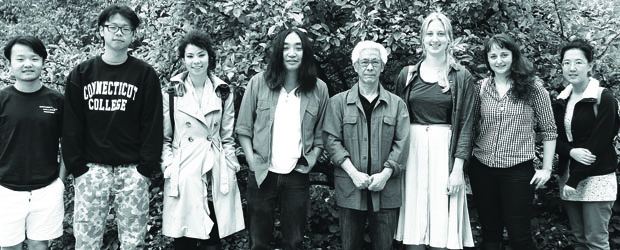On Thursday October 4, Chinese artist Zhang Hongtu spoke with students and faculty in the Chu room, in an event titled “Chinese Political Pop: Mixing Mao/Warhol.” Professor of Chinese and East Asian Languages and Cultures, Yibing Huang, organized the event in conjunction with the departments of East Asian Languages and Cultures and Art History.
The event was originally conceived for Huang’s class “Moments in Contemporary Chinese Art,” but Huang explained that he decided to open the event to the college community because of Zhang’s prominent status in the Chinese art world. “This public event is an attempt to bring together an internationally acclaimed Chinese artist with Connecticut College community to spark ideas about art, history, politics, revolutions, pop culture and modernism,” he said.
The discussion took a question and answer form. Hongtu discussed his experience in the Chinese Cultural revolution, his decision to move from China to New York in the 1980’s and the themes of his work, including Eastern and Western identity, censorship, cultural boundaries and labels in the art world. The conversation was then continued in Coffee Grounds, where students and faculty were able to speak with Hongtu in a more intimate setting.
Ikram Lakhdhar ’13 helped organize the event and felt it was a success. “We were able to draw a big audience from different academic and generational backgrounds that were curious enough to ask the artist pertinent questions,” she said.
The discussion served a dual purpose. It informed students about art and also gave them insight to life during the Cultural Revolution in China. “A lot of times, people claim they know about the Cultural Revolution and how it has shaped contemporary China, but the reality is that the only truthful knowledge comes from insiders and individuals who have lived through this historical change. I believe that it is very significant to bring together a contemporary Chinese artist and the Connecticut College community to exchange knowledge, spread ideas and challenge preconceived notions about China,” Lakhdhar said.
Hongtu’s most recognizable works are his images of Chairman Mao. Depictions of Mao in a traditionally Western context show up in his Long Live the Chairman Mao Series (1989) and The Last Banquet (1989). The series includes images of Chairman Mao with a moustache, pigtails and crossed eyes. The Last Banquet is a take on Leonardo da Vinci’s The Last Supper. Hongtu’s piece uses images of Chairman Mao in the place of Christ and his disciples.
When asked what advice he had to offer students and what reflections he would like students to take away from his work, Hongtu encouraged his audience to question the influence of society in their lives. He cited the ancient Chinese practice of foot binding to explain that practices that are inherent still need to be questioned. He said, “People still want to influence your ideas about society, culture, and yourselves. The best way to continue your life is to unbind… this is a lifetime job. We are all shaped or formed by something. But once we are unbound… we will feel spiritually and mentally free. This is the most important.”










aluminstroy.su